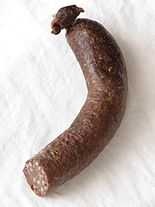Kaszanka
From Wikipedia, the free encyclopedia
| Kaszanka / Grützwurst | |
|---|---|
| Appetizer, main | |
 Traditional Kaszanka | |
| Alternative name(s): | |
| kiszka | |
| Serving temperature: | |
| Hot, cold | |
| Main ingredient(s): | |
| Pork, pig's blood, pig offal, kasza, onions, black pepper, marjoram | |
| Recipes at Wikibooks: | |
|
| |
| Media at Wikimedia Commons: | |
|
|
Kaszanka (or kiszka), in German Grützwurst, is a traditional blood sausage in Polish, Hungarian and German cuisine. It is made of a mixture of pig's blood, pig offal (commonly liver, lungs, skin, and fat), and buckwheat (sometimes barley or rice) kasza stuffed in a pig intestine. It is usually flavored with onion, black pepper, and marjoram.
Kaszanka may be eaten cold, but traditionally it is either grilled or fried with some onions and then served with potato and sauerkraut.
Elsewhere
- Grützwurst (Germany and sometimes Silesia)
- Knipp (Lower Saxony, Germany)
- Krupniok (More of a slight name difference than variation, Silesia)
- Pinkel (Northwest Germany)
- Stippgrütze (Westphalia, Germany)
- Westfälische Rinderwurst (Westphalia, Germany)
- Maischel (Carinthia, Austria): Grützwurst without blood and not cased in intestine, but worked into balls in caul fat. The name comes from the Slovenian majželj in turn derived from the Bavarian Maisen ("slices").[1]
- Jelito (Czech Republic)
- Jaternica (Slovak Republic)
- Hurka (Slovak Republic)
- Véres Hurka (Hungarian)
- Krovyanka (Ukraine)
See also
References
- ↑ Heinz Dieter Pohl. "Zum österreichischen Deutsch im Lichte der Sprachkontaktforschung" (in German). Retrieved 1.1.10.
External links
- A photograph of kaszanka
- A recipe for kiszka on YumYum.com
- Kaszanka or kiszka vendors in the United States: Chicopee Provision Co. (Chicopee, MA), Polana – A Polish Experience (Chicago, IL)
- Krupniok in Silesian cuisine
| |||||||||||||||||||||||||||||||||||||||||||||||||||||||||||||||||||||||||||||||||||||||||||||||||||||||||||||||
This article is issued from Wikipedia. The text is available under the Creative Commons Attribution/Share Alike; additional terms may apply for the media files.